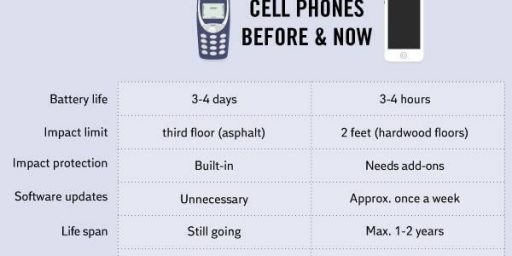Will Video Chat Take Off?
Video calling is becoming widely available. Will it become as common as talking on the phone?
Over at his Forbes blog, Alex Knapp asks, “Why Doesn’t Anyone Video Chat?” Answering his own question, he concludes:
I think it’s a bit early to write off video chatting. It’s only been in the past couple of years that the necessary bandwidth has been ubiquitous enough for people to take advantage of. And as bandwidth capabilities improve, so will video chatting applications and other hardware.
I think that it’s possible that it’s just one of those things that snowballs quickly. At first, only a few people video call. Then a few more. Then a few more. Then the next thing you know, almost everyone is. It may be, too, that there need to be one or two definitive video chatting platforms established before it becomes really common – just like it took Facebook and Twitter to be the dominant social media platform for social media to really take off.
But even as it becomes more common, I think there’s still going to be a lot of voice only calls. Heck, even on Star Trek using viewscreens was less common than using communicators.
Indeed, I’d argue that the overwhelming number of calls will remain voice-only.
Video is great for some things. We’ve been using Skype to video-chat with my parents/my mother since our first child was born more than two years ago. We only see each other in person three or four times a year, so it’s great to have a weekly chat where Katie can see her grandmother and vice-versa. At that age, kids change fast so seeing them is special. But it would never occur to me to set up the cameras to make a quick call to my mother. What would be the point?
Similarly, I’m shocked that videoconferencing hasn’t taken off more than it has in business. With air travel getting more expensive and aggravating all the time, video is a great way to gain productivity while still getting the personal connection that comes with putting a name to a face. At the same time, though, I prefer most of my business calls be voice-only so that I can multi-task. That’s especially true of long conference calls where I only half need to pay attention.
Despite the fact that everyone over the age of 3 apparently has a smart phone now, communication is increasingly moving to texting, emailing, direct messaging and the like rather than voice. With so many other avenues available, calling people up on the phone unexpectedly is considered more intrusive. One imagines a similar ethic will develop around video calling, since video is much more intrusive than voice.
It’s a wonderful technology in its place. But it should remain there.
Photo montage: TrekMovie.com






Indeed. I don’t always keep Skype open when I’m online but, when I do, I’ll occasionally get a call request from a family member who wants to video chat. It can be annoying. At least when you’re talking on the phone with someone you can get other work done without them really knowing about it. No such luck if the webcam is on.
Plus, you have to have clothes on.
No they got the future wrong.
Video is here, but it’s on you-tube. We don’t video chat, we publish to the world.
And being busy and information loaded, we just tweet and text as messaging.
(the star trek communicator was very much a cell phone. that was one good prediction.)
@Franklin: Yes. But presumably they’re much better for the sort of calls where being naked is a bonus.
(I’ve been in business situations where it would have been better to group people by geo-location and video-conference from actual conference rooms. Instead everyone did a long slow voice-skype conference, which had super low productivity because everyone was multi-tasking from their desks.)
We use internet conferencing daily in our office. We don’t see faces – we see sketches, drawings, graphics, spreadsheets, powerpoints, etc. It is an invaluable tool for us. Yes it saves money…but the biggest thing is time (which I hear is the same as money).
If we can save a consultant from having to drive here from the city, it means almost a full day saved – 2 +hrs driving each way, plus the meeting, plus the travel fatigue that wastes productivity for the rest of the day.
Two weeks ago we did a prospective job presentation at a private University. There were a group of people in the conference room, and trustees on the internet/phone hook-up. With the exception of the glad-handing after the presentation I really do not think the folks on the phone missed anything. And it prevented them from having to travel who knows how far for a :45 minute presentation.
Is it crucial to see faces? Maybe for J.J.’s first child. Not so much for business. I can see a face popping up after the powerpoint presentation is over. But I think that will happen when the infrastructure is there for other reasons – not because it’s necessary for carrying on business.
I thought it was gaining a lot of momentum. No? I know when I was working, I’d have leapt at the chance to video-conference rather than fly to, say, Albany. Now, New York City, well, that was different….
In several US Embassies in which I worked, video-conferencing with Washington was a weekly affair. The Country Team would sit around its conference table at one end while whomever at the DC end–it could be one person; it could be a group–was at the other. Sometimes, multi-point conferences were held.
The technology wasn’t the most svelte, though. It was being done via direct satellite link which added a lot of hoops to be jumped through. Given security concerns, I’m not sure high bandwidth would be any sort of solution, but perhaps better user interfaces would make it easier.
Going back 20 years, USIA–forerunner to State’s Office of Public Diplomacy–used an even more primitive video-conferencing methodology: World Net. This was the creation of Charles Wick, USIA Director under Reagan.
Video would be one-way, from the US via satellite, while audio was two-way via phone lines. Syncing the two was sometimes an issue, but more frequently the problem was dropped phone calls.
As flawed as this program was, it was still effective. It allowed us in the field to get speakers who could not/would not travel 24 hours to get to a foreign location. It was certainly cheaper, too.
As far as video phone calls go, the objections noted in comments above are right. Too, current mobile phones do not permit one to have the phone at a proper ‘portrait distance’ while still listening in. Even moving a camera to the inside of the phone would only show a close-up of an ear. Having the camera hovering a couple of feet in front of the person speaking would be amusing, though…
They mean play Angry Birds and eat Ring Dings.
@ Michael : Mostly, I check email and catch up on my Twitter feed, which I can do while maintaining some awareness of what’s happening on the call.
For business, I don’t see the need to look at the people you’re meeting with for most situations. And if you do need face-to-face, chances are you’re going to travel rather than use video chat. Seems to me that most business situations where video conferencing would be used are project-based, and thus it’s much more useful to use GoToMeeting or another similar service so the callers can all view the presentation onscreen. I need to hear what the people on the call or saying, but I don’t need to be looking at them. In fact, that could be a distraction from the work at hand in some cases.
For non-business use, I’ve often thought about how video chat never took off when the technology first presented itself because people had to buy new, expensive technology. If they have multiple phones in the house, would they replace them all with video phones? And even if you have them to use, almost nobody else would, so it was a big waste of money. Now, however, we all seem to have smartphones (or a lot of us, anyway), and some of us don’t even have land lines or multiple phones anymore. Many new smartphones feature dual cameras, front and back (like my new Thunderbolt), and can very easily be used as video phones. What used to be a cumbersome, expensive technology to use is now becoming readily available at no real additional cost to the smartphone consumer. That’s not even mentioning the fact that user-facing cameras are already on a great many laptop and desktop computer.
So, the technology has caught up to an idea. The question is will more people use the technology? Not many, I’m guessing. I’m as big a tech geek as there is, and I have no interest in video chat, except to see my nephews on Skype occasionally. I don’t want to have to worry about how I look every time the phone rings. The technological hassles are being removed. The social hassles aren’t going anywhere.